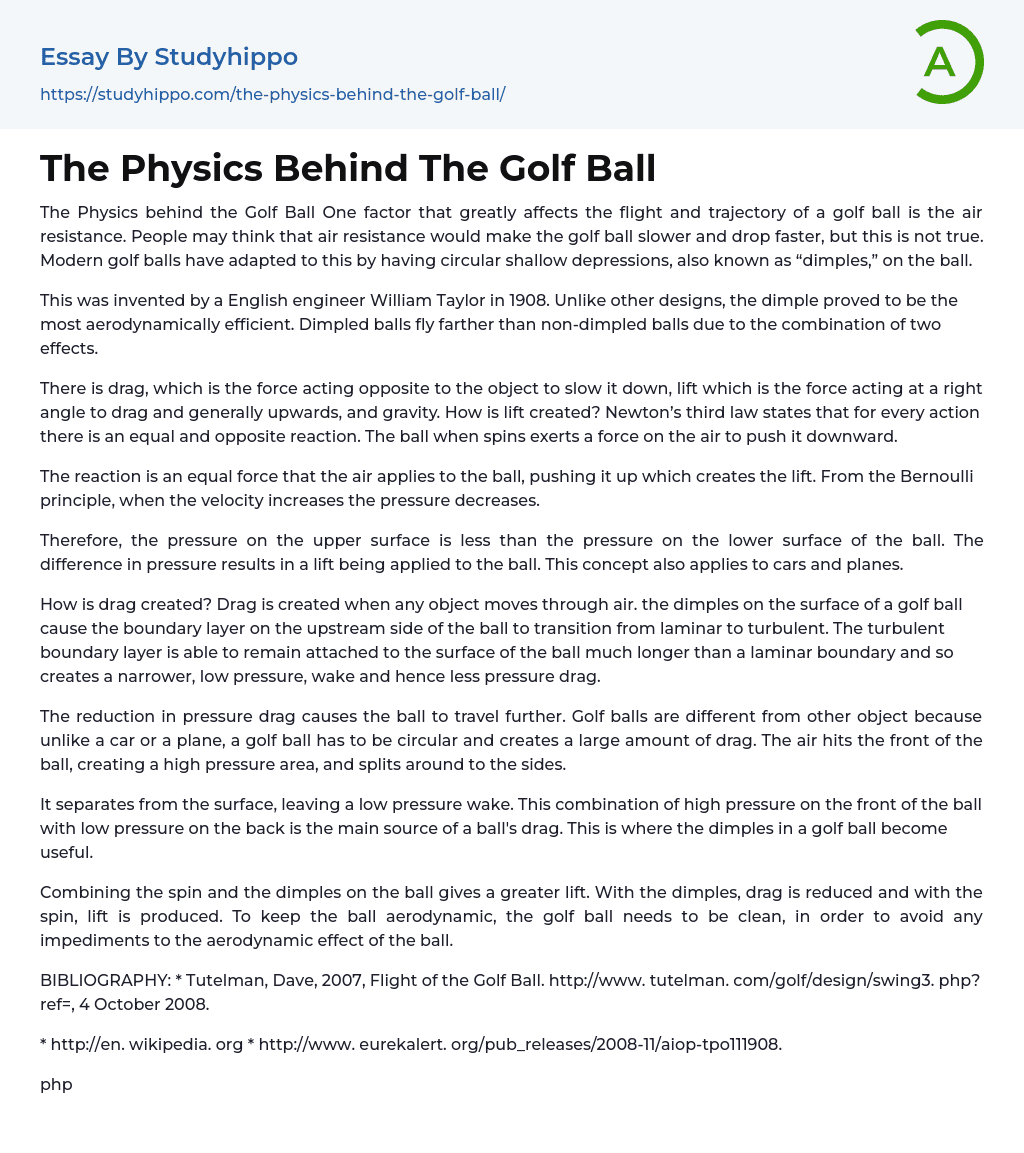The Physics behind the Golf Ball One factor that greatly affects the flight and trajectory of a golf ball is the air resistance. People may think that air resistance would make the golf ball slower and drop faster, but this is not true. Modern golf balls have adapted to this by having circular shallow depressions, also known as “dimples,” on the ball.
This was invented by a English engineer William Taylor in 1908. Unlike other designs, the dimple proved to be the most aerodynamically efficient. Dimpled balls fly farther than non-dimpled balls due to the combination of two effects.
There is drag, which is the force acting opposite to the object to slow it down, lift which is the force acting at a right angle to drag and generally upwards, and gravity. How
...is lift created? Newton’s third law states that for every action there is an equal and opposite reaction. The ball when spins exerts a force on the air to push it downward.
The reaction is an equal force that the air applies to the ball, pushing it up which creates the lift. From the Bernoulli principle, when the velocity increases the pressure decreases.
Therefore, the pressure on the upper surface is less than the pressure on the lower surface of the ball. The difference in pressure results in a lift being applied to the ball. This concept also applies to cars and planes.
How is drag created? Drag is created when any object moves through air. the dimples on the surface of a golf ball cause the boundary layer on the upstream side of the ball to transition from laminar to
turbulent. The turbulent boundary layer is able to remain attached to the surface of the ball much longer than a laminar boundary and so creates a narrower, low pressure, wake and hence less pressure drag.
The reduction in pressure drag causes the ball to travel further. Golf balls are different from other object because unlike a car or a plane, a golf ball has to be circular and creates a large amount of drag. The air hits the front of the ball, creating a high pressure area, and splits around to the sides.
It separates from the surface, leaving a low pressure wake. This combination of high pressure on the front of the ball with low pressure on the back is the main source of a ball's drag. This is where the dimples in a golf ball become useful.
Combining the spin and the dimples on the ball gives a greater lift. With the dimples, drag is reduced and with the spin, lift is produced. To keep the ball aerodynamic, the golf ball needs to be clean, in order to avoid any impediments to the aerodynamic effect of the ball.
BIBLIOGRAPHY: * Tutelman, Dave, 2007, Flight of the Golf Ball. http://www. tutelman. com/golf/design/swing3. php? ref=, 4 October 2008.
* http://en. wikipedia. org * http://www. eurekalert. org/pub_releases/2008-11/aiop-tpo111908.
php
- Oxygen essays
- Atmosphere essays
- Coral Reef essays
- Desert essays
- Earth essays
- Ocean essays
- Lake essays
- Sea essays
- Biodiversity essays
- Natural Environment essays
- Forest essays
- Soil essays
- Water essays
- Rainbow essays
- Ecosystem essays
- Volcano essays
- Wind essays
- Forestry essays
- Bottled Water essays
- Atom essays
- Big Bang Theory essays
- Density essays
- Electricity essays
- Energy essays
- Force essays
- Heat essays
- Light essays
- Motion essays
- Nuclear Power essays
- Physiology essays
- Sound essays
- Speed essays
- Temperature essays
- Thermodynamics essays
- American Football essays
- Athletes essays
- Athletic Shoe essays
- badminton essays
- Baseball essays
- Basketball essays
- Benefits of Exercise essays
- Bodybuilding essays
- Boxing essays
- cricket essays
- Fight club essays
- Football essays
- go kart essays
- Golf essays
- Gym essays
- hockey essays




